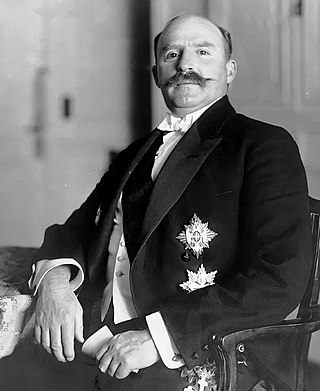
Essad Toptani was an Albanian politician who served as prime minister of Albania from 1914 to 1916. He previously established the Republic of Central Albania based in Durrës. An Ottoman army officer, he served as the Albanian deputy in the Ottoman Parliament and later cooperated with the Balkan League after the Balkan Wars.

Sulejman Pasha Bargjini was an ethnic Albanian general, nobleman and Governor of the Ottoman Empire. He was originally from Bargjin, but he settled in the village of Mullet, Albania and probably served as a Janissary, he was given the title Pasha. As an ethnic Albanian, he had fought for the Ottomans against the Safavids in Persia. After that he had built a mosque, a bakery and a hammam. He founded the settlement of Tirana, now the capital of Albania, in 1614 as an oriental-style town of those times. According to some local legends, he named the town he founded after Tehran, the capital of Persia. This, however, is a folk etymology without basis in fact, as Tirana was already mentioned in Venetian documents as early as 1418.

Futboll Klub Partizani, or FK Partizani for short, is an Albanian professional football club based in Tirana, that competes in the Kategoria Superiore. Founded in 1946, the club was historically affiliated to the Albanian army. Partizani's home ground is the newly built stadium at Partizani Complex.
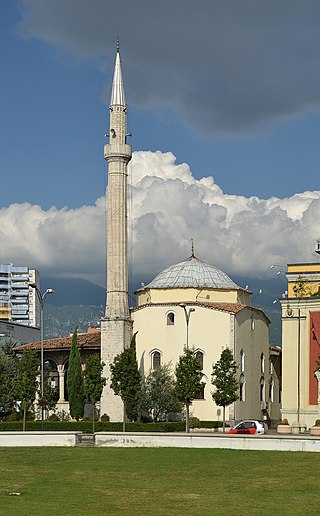
The Hajji Et'hem Bey Mosque is a mosque in Tirana, Albania. Closed under communist rule, the mosque reopened as a house of worship in 1991. Without permission from the authorities, 10,000 people attended and the police did not interfere. Frescoes outside and in the portico depict trees, waterfalls and bridges.

Tepelenë is a city and a municipality in Gjirokastër County, in the south of Albania. The town is on the left bank of the Vjosa River, about three kilometres downstream from its union with the Drino.
Sulejman Demollari also known as Sul Demollari is an Albanian former football player and coach.
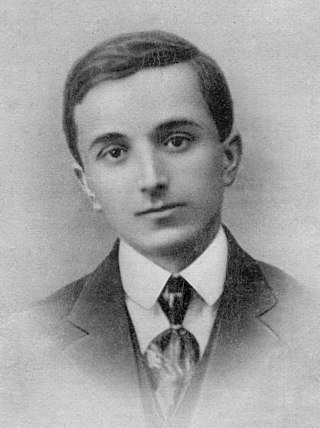
Avni Rustemi was an Albanian patriot, militant, teacher, activist and member of the Albanian parliament. Rustemi was the leader of both democratic organisations "Atdheu" and "Bashkimi", and also a member of the democratic opposition in the Albanian National Assembly preceding the Revolution of June 1924. He is also known for assassinating Essad Pasha Toptani.
Sulejman Haxhi Mema is a former player and manager of Tirana Youth. He has also been head of refereeing at the Football Association of Albania.

Gjon II Kastrioti, was the son of Gjergj Kastrioti Skanderbeg, the Albanian national hero, and of Donika Kastrioti, daughter of the powerful Albanian prince, Gjergj Arianiti. He was for a short time Lord of Kruja after his father's death, then Duke of San Pietro in Galatina (1485), Count of Soleto, Signore of Monte Sant'Angelo and San Giovanni Rotondo. In 1495, Ferdinand I of Naples gave him the title of the Signore of Gagliano del Capo and Oria. While in his teens, he was forced to leave the country after the death of his father in 1468. He is known also for his role in the Albanian Uprisings of 1481, when, after reaching the Albanian coast from Italy, settling in Himara, he led a rebellion against the Ottomans. In June 1481, he supported forces of Ivan Crnojević to successfully recapture Zeta from the Ottomans. He was unable to re-establish the Kastrioti Principality and liberate Albania from the Ottomans, and he retired in Italy after three years of war in 1484.

The Sulejman Pasha Tomb was the tomb of the Ottoman general of Albanian origin named Sulejman Bargjini. The tomb was ruined in November 1944 together with the Sulejman Pasha Mosque, and subsequently destroyed by the communist government. The monument of the "Unknown Soldier" was built later upon their former location.
Tirana is the capital and the largest city of Albania. Modern Tirana was founded as an Ottoman town in 1614 by Sulejman Bargjini, a local ruler from Mullet, although the area has been continuously inhabited since antiquity. Tirana became Albania's capital city in 1920 and has a population of over 600,000. The city is home to many universities and is the center of the political, economical, and cultural life of the country.

Sulejman Zalla (1892–1966) was an Albanian teacher, patriot and activist of the Rilindja Kombëtare of the early 20th century. He was the founder of the first modern Albanian school in the County of Durrës.
Sulejman Starova is an Albanian football coach and retired player.
Molla Mehmet Bey known as Molla Bey of Petrela was an Ottoman-Albanian religious leader and benefactor from Tirana. Born with the name Mehmet, he was a descendant of Sulejman Pasha Bargjini, the Ottoman Albanian general from nearby Mullet who transformed Tirana into a developed commercial and religious center.

Haxhi Et'hem Bey also known as Haxhi Et'hem bey Mollaj (1783–1846) was an Ottoman Albanian administrator, nobleman and bejtexhi.
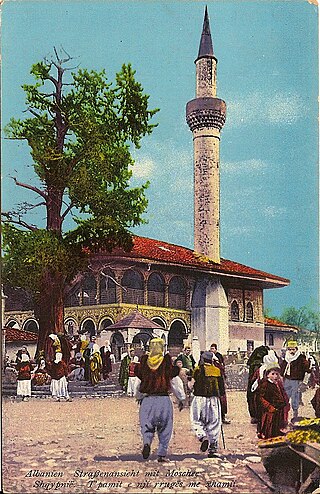
The Old Mosque or Sulejman Pasha mosque was the founding mosque of the Albanian capital Tirana. The city developed around the mosque, which was founded by the Ottoman Albanian Pasha Sulejman Bargjini along with a hammam and a bakery. In the mid of the 20th century, all of it was razed to make place for the Communist-era Unknown Soldier statue.
Sulejman is the Bosnian and Albanian variant of Suleiman as a given name and surname. It means "man of peace". It may refer to:
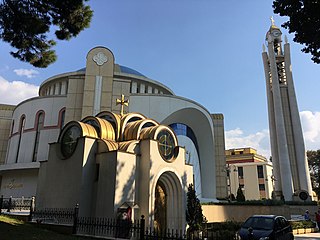
There are many landmarks in Tirana, Albania some of which are of considerable historical or artistic interest. Many monuments and landmarks situated in Tirana, date back to the Illyrian, Roman, Greek and Ottoman periods.
Sulejman Aga Batusha or Sulejman Aga Botusha was a prominent Albanian resistance fighter and revolutionary leader from the Highlands of Gjakova and the wider Gjakova region who participated in the Albanian National Awakening. Born sometime in the 19th century, Sulejman Aga would repeatedly lead Albanian forces against the Ottomans throughout the 19th and 20th centuries, ultimately contributing to the Albanian Declaration of Independence from the Ottoman Empire. He was also a chief of the Gashi tribe and was their head in the Gjakova region.











